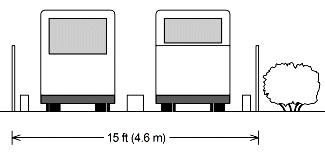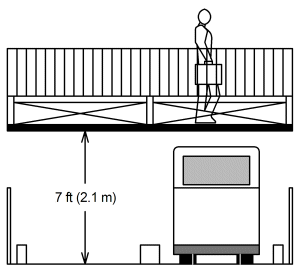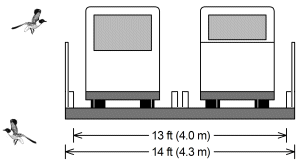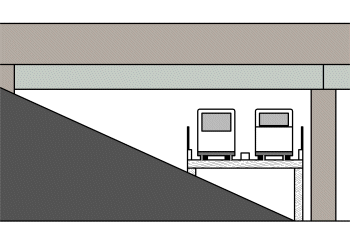Automated Microbus Exclusive Roadway

The Automated Microbus exclusive roadway would be mostly at grade. It would be two-way everywhere, allowing easy evacuation of passengers from a failed vehicle to one in the adjacent lane. The two lanes are separated by a central barrier approximately 1 ft (0.3 m) high. Considering the limited speed and power of the vehicles, this should prevent all head-on collisions in event of control system failure.
A fence approximately 4 ft (1.2 m) high serves to isolate the roadway. A requirement of the vehicle control system is that it can detect a trespasser on the roadway and bring the vehicle to a stop. A forward looking exterior video camera would allow central control to assess the situation. A somewhat higher fence might be needed in certain areas of heavy pedestrian concentration, such as near stations.
 Pedestrians would cross the roadway only at designated points. These could either be grade separated, as shown at the right, or at grade. If grade separated, the Microbus roadway would ideally drop several feet (about 1 m) below grade in an open cut as it passed beneath the pedestrian overpass. An at-grade pedestrian crossing with power gates would be appropriate in cases where both the pedestrian and Microbus volumes were low. When someone wanted to cross at grade, he or she would press a button to open gates in the fences on both sides of the roadway. If a Microbus was about to pass, the opening would be delayed until it was safe to cross. Sensors would ensure the gates wouldn't close until the crosswalk was clear. All at-grade crossings would be monitored with closed circuit TV.
Pedestrians would cross the roadway only at designated points. These could either be grade separated, as shown at the right, or at grade. If grade separated, the Microbus roadway would ideally drop several feet (about 1 m) below grade in an open cut as it passed beneath the pedestrian overpass. An at-grade pedestrian crossing with power gates would be appropriate in cases where both the pedestrian and Microbus volumes were low. When someone wanted to cross at grade, he or she would press a button to open gates in the fences on both sides of the roadway. If a Microbus was about to pass, the opening would be delayed until it was safe to cross. Sensors would ensure the gates wouldn't close until the crosswalk was clear. All at-grade crossings would be monitored with closed circuit TV.
Since the vehicles are small and lightweight and run at moderate speed (25 mph (40 km/hr)), the roadway can be built to lighter standards than an ordinary highway, which has to carry at least some heavy trucks. This will keep construction costs low. The 15 ft (4.6 m) total right of way is based on 4.5 ft wide vehicles with 9 inches (23 cm) of clearance on each side. Additional space is taken up by a center divider one foot (0.3 m) wide, plus one foot of clearance on each side between the fence and the inner edge of a guard rail.

When the exclusive roadway needs to cross a conventional road or other obstacle, a short tunnel could be the most efficient solution. The Microbus roadway only requires about 7 ft (2.1 m) of vertical clearance, while a Microbus bridge would have to pass over a highway with about 16.5 ft (5 m) of clearance. Depending on the thickness of the supporting structures, a Microbus bridge would require about twice the elevation change in the approaches compared with a tunnel. In addition, there is the visual impact of a bridge and its approaches to be considered.
In the Microbus tunnel diagram, the parts that are both continuous and load bearing are shaded. There are two rows of columns about one foot (0.3 m) thick running the length of the tunnel. The columns in each row are spaced on 5 ft (1.5 m) centers. The 4 ft (1.2 m) openings between columns in the same row allow passengers in a failed vehicle to be evacuated directly across the tunnel to a vehicle in the adjacent lane. (Vehicle doors open to the inside of the two-way roadway, the opposite of an ordinary bus.) Even if a vehicle stopped with a column centered on it's 5 ft wide doors, there would be a 24 inch (61 cm) wide opening on each side of the column for riders to exit the vehicle. If passengers had to immediately exit the tunnel on foot, there is a 3-foot (0.9 m) wide emergency walkway between the rows of columns.
Microbus tunnels have issues that make them impractical in some situations. There may be drainage problems. They may conflict with utilities running underneath the cross street. This is briefly considered in the Beltway Shuttle application involving an Microbus route running next to a freeway.
 Aerial Microbus roadways (bridges) would be used in cases where tunnels were impractical. Since they could serve as emergency walkways, they would be fenced as shown. They would be slightly narrower than at-grade roadways, since the fences could be closer to the vehicles. In an at-grade setting, there is always the concern that a person outside the fence could lean over into the path of a vehicle.
Aerial Microbus roadways (bridges) would be used in cases where tunnels were impractical. Since they could serve as emergency walkways, they would be fenced as shown. They would be slightly narrower than at-grade roadways, since the fences could be closer to the vehicles. In an at-grade setting, there is always the concern that a person outside the fence could lean over into the path of a vehicle.
Proposed systems of small, automated vehicles are usually assumed to operate mostly or entirely on aerial guideways or roadways (a "guideway" provides mechanical lateral guidance). Aerial structures require only small footings at ground level and, in theory, can be built almost anywhere in an urban area without interfering with existing roads or taking significant quantities of land. However, they are much more expensive than at-grade roadways, and can generate intense opposition on esthetic grounds.

In addition to the at-grade roadway, tunnels, and bridges considered above, there are special cases. The minimal vertical clearance needed by the Microbus roadway allows it to fit in places unsuitable for a normal highway lane. This makes applications like the Beltway Shuttle possible.